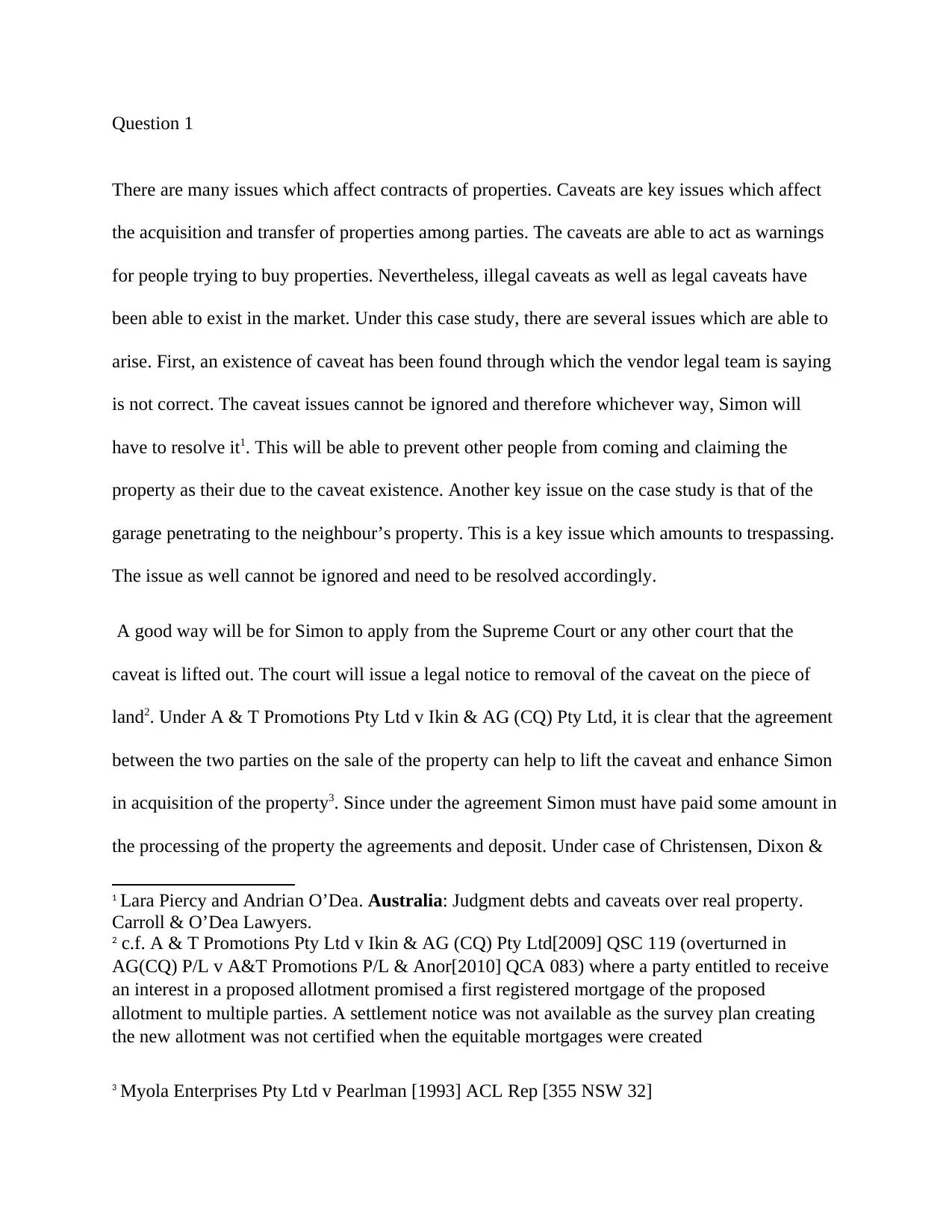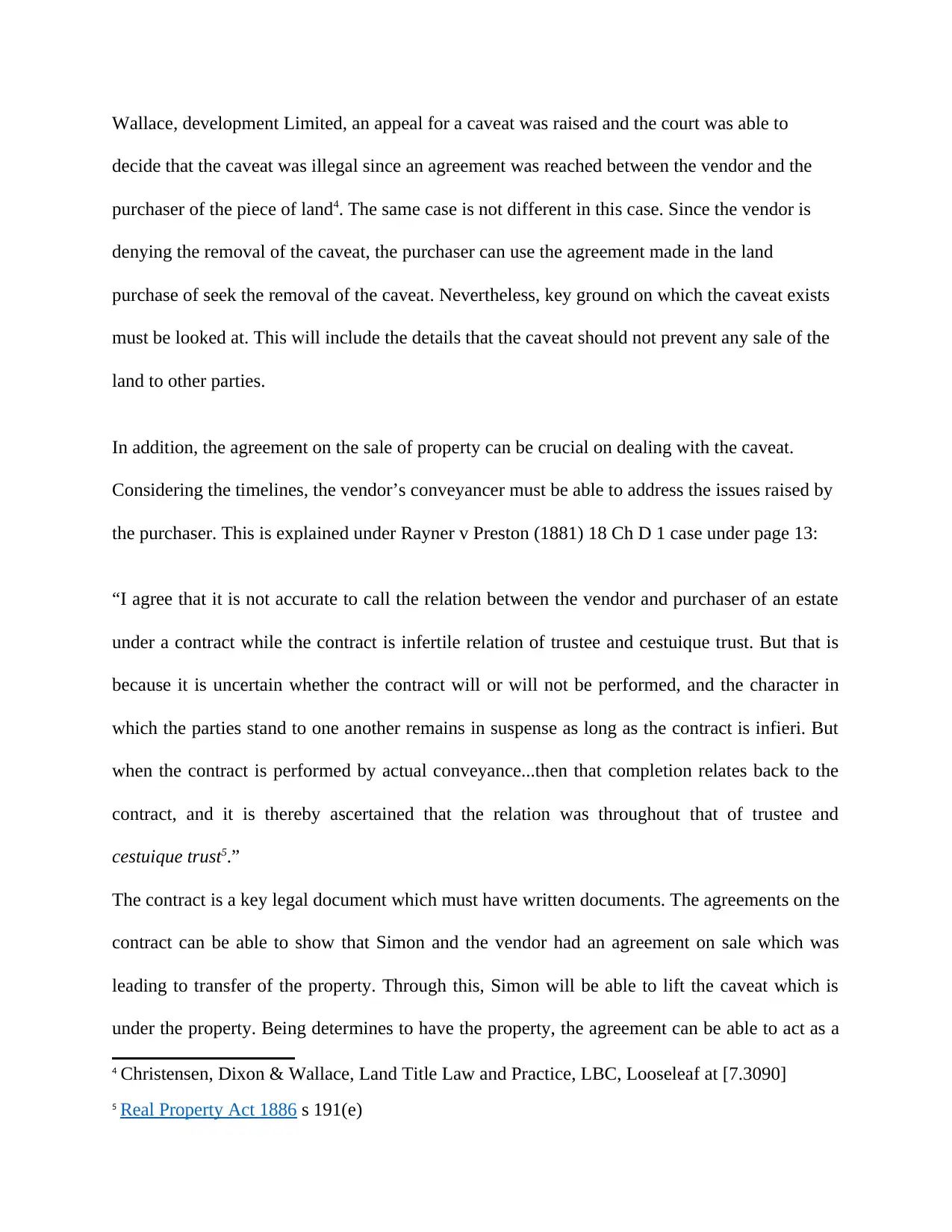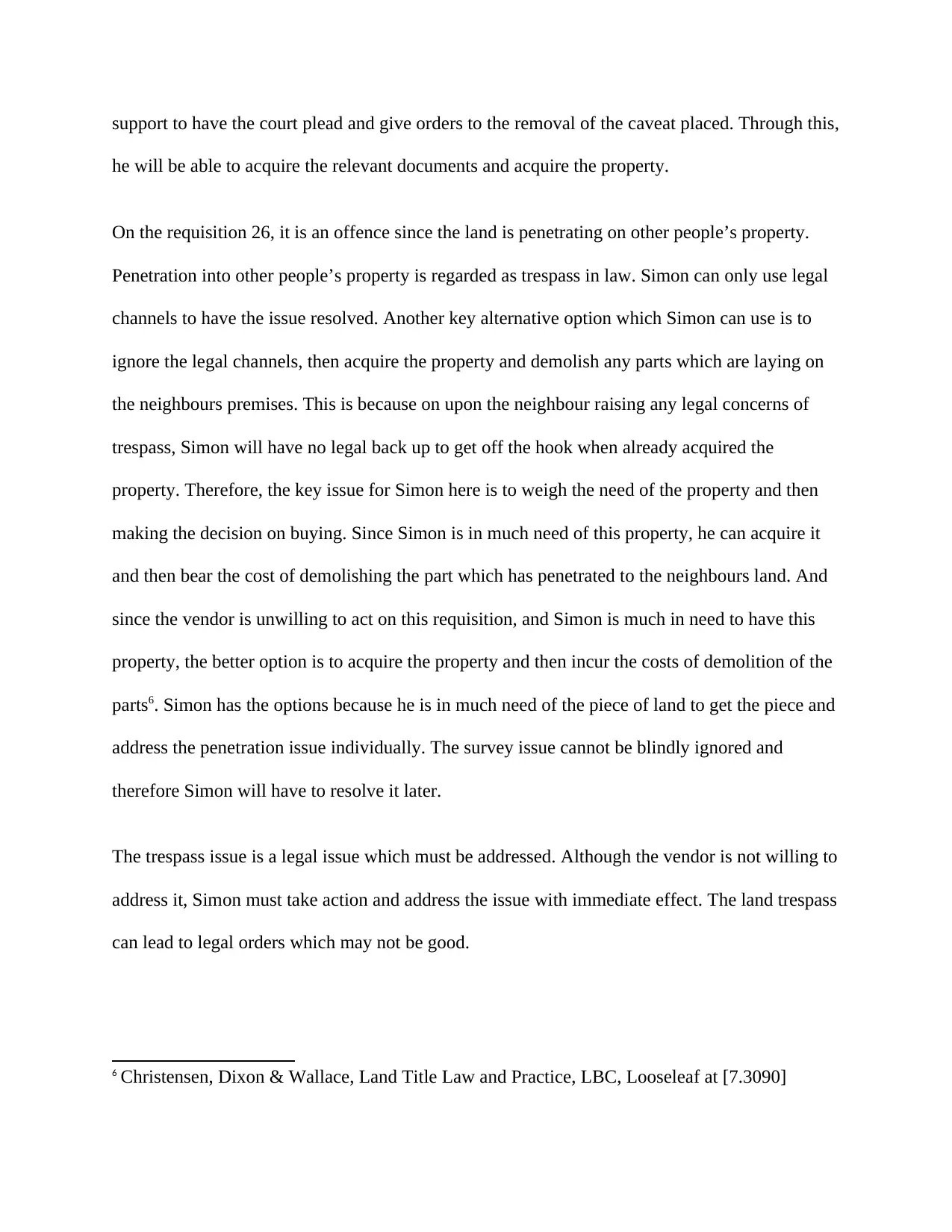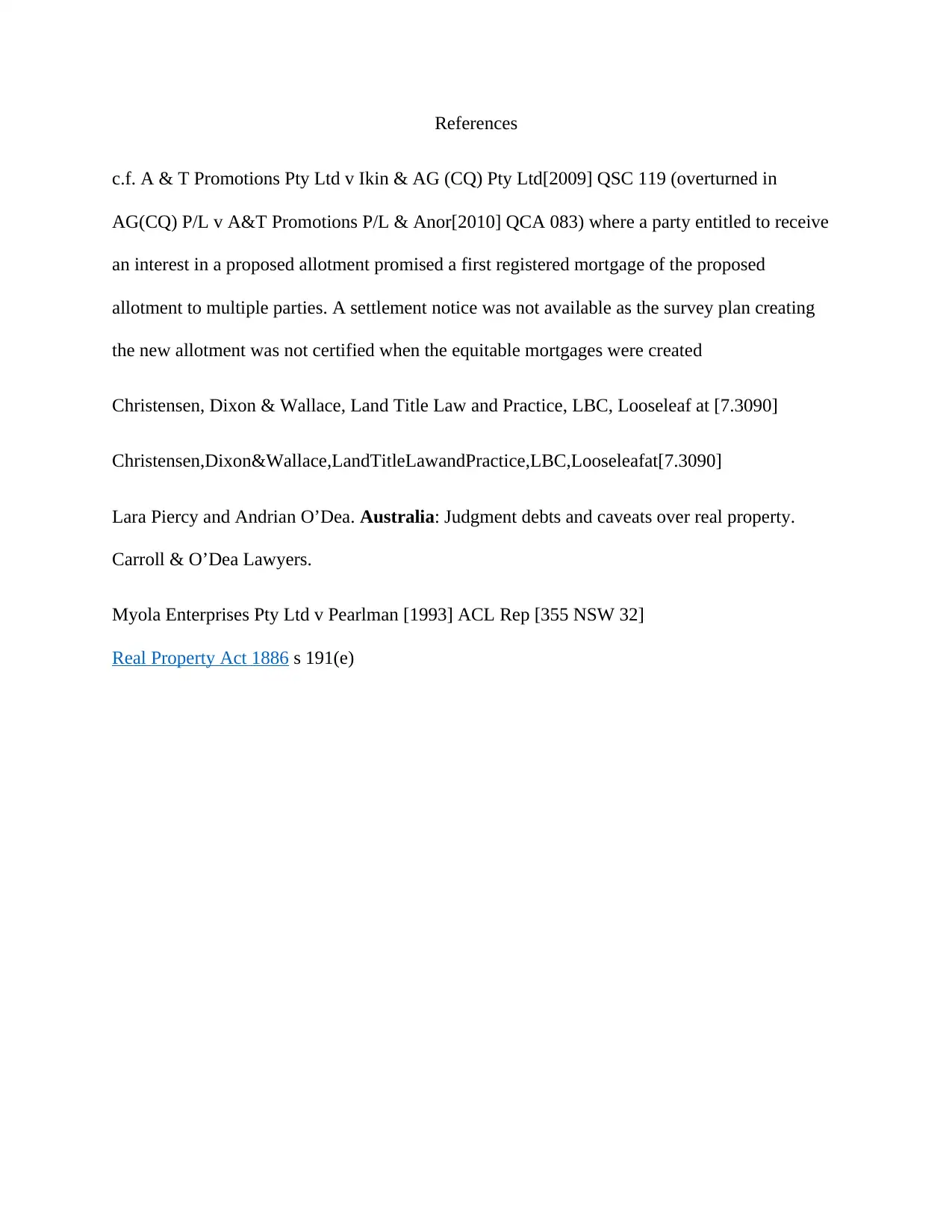Property Law Case Study: Analyzing Caveats, Trespass, and Contracts
VerifiedAdded on 2020/04/15
|5
|1176
|67
Case Study
AI Summary
This case study examines a property law dispute involving a potential property purchase by Simon, highlighting key issues such as the existence of a caveat and a garage encroaching on a neighbor's property. The analysis delves into the implications of the caveat, which the vendor claims is incorrect, and the legal ramifications of the trespass. The document references relevant legal precedents, including A & T Promotions Pty Ltd v Ikin & AG (CQ) Pty Ltd and Rayner v Preston, to support arguments regarding contract law and the lifting of the caveat. It explores Simon's options, including legal action to remove the caveat and address the trespass, emphasizing the importance of considering the property's value and the vendor's willingness to resolve the issues. The study underscores the need for Simon to address the survey and trespass issues, regardless of the vendor's stance, to avoid future legal complications. The conclusion highlights Simon's options to acquire the property and address the penetration issue individually.

Name:
Course:
Professor:
Date:
Course:
Professor:
Date:
Paraphrase This Document
Need a fresh take? Get an instant paraphrase of this document with our AI Paraphraser

Question 1
There are many issues which affect contracts of properties. Caveats are key issues which affect
the acquisition and transfer of properties among parties. The caveats are able to act as warnings
for people trying to buy properties. Nevertheless, illegal caveats as well as legal caveats have
been able to exist in the market. Under this case study, there are several issues which are able to
arise. First, an existence of caveat has been found through which the vendor legal team is saying
is not correct. The caveat issues cannot be ignored and therefore whichever way, Simon will
have to resolve it1. This will be able to prevent other people from coming and claiming the
property as their due to the caveat existence. Another key issue on the case study is that of the
garage penetrating to the neighbour’s property. This is a key issue which amounts to trespassing.
The issue as well cannot be ignored and need to be resolved accordingly.
A good way will be for Simon to apply from the Supreme Court or any other court that the
caveat is lifted out. The court will issue a legal notice to removal of the caveat on the piece of
land2. Under A & T Promotions Pty Ltd v Ikin & AG (CQ) Pty Ltd, it is clear that the agreement
between the two parties on the sale of the property can help to lift the caveat and enhance Simon
in acquisition of the property3. Since under the agreement Simon must have paid some amount in
the processing of the property the agreements and deposit. Under case of Christensen, Dixon &
1 Lara Piercy and Andrian O’Dea. Australia: Judgment debts and caveats over real property.
Carroll & O’Dea Lawyers.
2 c.f. A & T Promotions Pty Ltd v Ikin & AG (CQ) Pty Ltd[2009] QSC 119 (overturned in
AG(CQ) P/L v A&T Promotions P/L & Anor[2010] QCA 083) where a party entitled to receive
an interest in a proposed allotment promised a first registered mortgage of the proposed
allotment to multiple parties. A settlement notice was not available as the survey plan creating
the new allotment was not certified when the equitable mortgages were created
3 Myola Enterprises Pty Ltd v Pearlman [1993] ACL Rep [355 NSW 32]
There are many issues which affect contracts of properties. Caveats are key issues which affect
the acquisition and transfer of properties among parties. The caveats are able to act as warnings
for people trying to buy properties. Nevertheless, illegal caveats as well as legal caveats have
been able to exist in the market. Under this case study, there are several issues which are able to
arise. First, an existence of caveat has been found through which the vendor legal team is saying
is not correct. The caveat issues cannot be ignored and therefore whichever way, Simon will
have to resolve it1. This will be able to prevent other people from coming and claiming the
property as their due to the caveat existence. Another key issue on the case study is that of the
garage penetrating to the neighbour’s property. This is a key issue which amounts to trespassing.
The issue as well cannot be ignored and need to be resolved accordingly.
A good way will be for Simon to apply from the Supreme Court or any other court that the
caveat is lifted out. The court will issue a legal notice to removal of the caveat on the piece of
land2. Under A & T Promotions Pty Ltd v Ikin & AG (CQ) Pty Ltd, it is clear that the agreement
between the two parties on the sale of the property can help to lift the caveat and enhance Simon
in acquisition of the property3. Since under the agreement Simon must have paid some amount in
the processing of the property the agreements and deposit. Under case of Christensen, Dixon &
1 Lara Piercy and Andrian O’Dea. Australia: Judgment debts and caveats over real property.
Carroll & O’Dea Lawyers.
2 c.f. A & T Promotions Pty Ltd v Ikin & AG (CQ) Pty Ltd[2009] QSC 119 (overturned in
AG(CQ) P/L v A&T Promotions P/L & Anor[2010] QCA 083) where a party entitled to receive
an interest in a proposed allotment promised a first registered mortgage of the proposed
allotment to multiple parties. A settlement notice was not available as the survey plan creating
the new allotment was not certified when the equitable mortgages were created
3 Myola Enterprises Pty Ltd v Pearlman [1993] ACL Rep [355 NSW 32]

Wallace, development Limited, an appeal for a caveat was raised and the court was able to
decide that the caveat was illegal since an agreement was reached between the vendor and the
purchaser of the piece of land4. The same case is not different in this case. Since the vendor is
denying the removal of the caveat, the purchaser can use the agreement made in the land
purchase of seek the removal of the caveat. Nevertheless, key ground on which the caveat exists
must be looked at. This will include the details that the caveat should not prevent any sale of the
land to other parties.
In addition, the agreement on the sale of property can be crucial on dealing with the caveat.
Considering the timelines, the vendor’s conveyancer must be able to address the issues raised by
the purchaser. This is explained under Rayner v Preston (1881) 18 Ch D 1 case under page 13:
“I agree that it is not accurate to call the relation between the vendor and purchaser of an estate
under a contract while the contract is infertile relation of trustee and cestuique trust. But that is
because it is uncertain whether the contract will or will not be performed, and the character in
which the parties stand to one another remains in suspense as long as the contract is infieri. But
when the contract is performed by actual conveyance...then that completion relates back to the
contract, and it is thereby ascertained that the relation was throughout that of trustee and
cestuique trust5.”
The contract is a key legal document which must have written documents. The agreements on the
contract can be able to show that Simon and the vendor had an agreement on sale which was
leading to transfer of the property. Through this, Simon will be able to lift the caveat which is
under the property. Being determines to have the property, the agreement can be able to act as a
4 Christensen, Dixon & Wallace, Land Title Law and Practice, LBC, Looseleaf at [7.3090]
5 Real Property Act 1886 s 191(e)
decide that the caveat was illegal since an agreement was reached between the vendor and the
purchaser of the piece of land4. The same case is not different in this case. Since the vendor is
denying the removal of the caveat, the purchaser can use the agreement made in the land
purchase of seek the removal of the caveat. Nevertheless, key ground on which the caveat exists
must be looked at. This will include the details that the caveat should not prevent any sale of the
land to other parties.
In addition, the agreement on the sale of property can be crucial on dealing with the caveat.
Considering the timelines, the vendor’s conveyancer must be able to address the issues raised by
the purchaser. This is explained under Rayner v Preston (1881) 18 Ch D 1 case under page 13:
“I agree that it is not accurate to call the relation between the vendor and purchaser of an estate
under a contract while the contract is infertile relation of trustee and cestuique trust. But that is
because it is uncertain whether the contract will or will not be performed, and the character in
which the parties stand to one another remains in suspense as long as the contract is infieri. But
when the contract is performed by actual conveyance...then that completion relates back to the
contract, and it is thereby ascertained that the relation was throughout that of trustee and
cestuique trust5.”
The contract is a key legal document which must have written documents. The agreements on the
contract can be able to show that Simon and the vendor had an agreement on sale which was
leading to transfer of the property. Through this, Simon will be able to lift the caveat which is
under the property. Being determines to have the property, the agreement can be able to act as a
4 Christensen, Dixon & Wallace, Land Title Law and Practice, LBC, Looseleaf at [7.3090]
5 Real Property Act 1886 s 191(e)
⊘ This is a preview!⊘
Do you want full access?
Subscribe today to unlock all pages.

Trusted by 1+ million students worldwide

support to have the court plead and give orders to the removal of the caveat placed. Through this,
he will be able to acquire the relevant documents and acquire the property.
On the requisition 26, it is an offence since the land is penetrating on other people’s property.
Penetration into other people’s property is regarded as trespass in law. Simon can only use legal
channels to have the issue resolved. Another key alternative option which Simon can use is to
ignore the legal channels, then acquire the property and demolish any parts which are laying on
the neighbours premises. This is because on upon the neighbour raising any legal concerns of
trespass, Simon will have no legal back up to get off the hook when already acquired the
property. Therefore, the key issue for Simon here is to weigh the need of the property and then
making the decision on buying. Since Simon is in much need of this property, he can acquire it
and then bear the cost of demolishing the part which has penetrated to the neighbours land. And
since the vendor is unwilling to act on this requisition, and Simon is much in need to have this
property, the better option is to acquire the property and then incur the costs of demolition of the
parts6. Simon has the options because he is in much need of the piece of land to get the piece and
address the penetration issue individually. The survey issue cannot be blindly ignored and
therefore Simon will have to resolve it later.
The trespass issue is a legal issue which must be addressed. Although the vendor is not willing to
address it, Simon must take action and address the issue with immediate effect. The land trespass
can lead to legal orders which may not be good.
6 Christensen, Dixon & Wallace, Land Title Law and Practice, LBC, Looseleaf at [7.3090]
he will be able to acquire the relevant documents and acquire the property.
On the requisition 26, it is an offence since the land is penetrating on other people’s property.
Penetration into other people’s property is regarded as trespass in law. Simon can only use legal
channels to have the issue resolved. Another key alternative option which Simon can use is to
ignore the legal channels, then acquire the property and demolish any parts which are laying on
the neighbours premises. This is because on upon the neighbour raising any legal concerns of
trespass, Simon will have no legal back up to get off the hook when already acquired the
property. Therefore, the key issue for Simon here is to weigh the need of the property and then
making the decision on buying. Since Simon is in much need of this property, he can acquire it
and then bear the cost of demolishing the part which has penetrated to the neighbours land. And
since the vendor is unwilling to act on this requisition, and Simon is much in need to have this
property, the better option is to acquire the property and then incur the costs of demolition of the
parts6. Simon has the options because he is in much need of the piece of land to get the piece and
address the penetration issue individually. The survey issue cannot be blindly ignored and
therefore Simon will have to resolve it later.
The trespass issue is a legal issue which must be addressed. Although the vendor is not willing to
address it, Simon must take action and address the issue with immediate effect. The land trespass
can lead to legal orders which may not be good.
6 Christensen, Dixon & Wallace, Land Title Law and Practice, LBC, Looseleaf at [7.3090]
Paraphrase This Document
Need a fresh take? Get an instant paraphrase of this document with our AI Paraphraser

References
c.f. A & T Promotions Pty Ltd v Ikin & AG (CQ) Pty Ltd[2009] QSC 119 (overturned in
AG(CQ) P/L v A&T Promotions P/L & Anor[2010] QCA 083) where a party entitled to receive
an interest in a proposed allotment promised a first registered mortgage of the proposed
allotment to multiple parties. A settlement notice was not available as the survey plan creating
the new allotment was not certified when the equitable mortgages were created
Christensen, Dixon & Wallace, Land Title Law and Practice, LBC, Looseleaf at [7.3090]
Christensen,Dixon&Wallace,LandTitleLawandPractice,LBC,Looseleafat[7.3090]
Lara Piercy and Andrian O’Dea. Australia: Judgment debts and caveats over real property.
Carroll & O’Dea Lawyers.
Myola Enterprises Pty Ltd v Pearlman [1993] ACL Rep [355 NSW 32]
Real Property Act 1886 s 191(e)
c.f. A & T Promotions Pty Ltd v Ikin & AG (CQ) Pty Ltd[2009] QSC 119 (overturned in
AG(CQ) P/L v A&T Promotions P/L & Anor[2010] QCA 083) where a party entitled to receive
an interest in a proposed allotment promised a first registered mortgage of the proposed
allotment to multiple parties. A settlement notice was not available as the survey plan creating
the new allotment was not certified when the equitable mortgages were created
Christensen, Dixon & Wallace, Land Title Law and Practice, LBC, Looseleaf at [7.3090]
Christensen,Dixon&Wallace,LandTitleLawandPractice,LBC,Looseleafat[7.3090]
Lara Piercy and Andrian O’Dea. Australia: Judgment debts and caveats over real property.
Carroll & O’Dea Lawyers.
Myola Enterprises Pty Ltd v Pearlman [1993] ACL Rep [355 NSW 32]
Real Property Act 1886 s 191(e)
1 out of 5
Related Documents
Your All-in-One AI-Powered Toolkit for Academic Success.
+13062052269
info@desklib.com
Available 24*7 on WhatsApp / Email
![[object Object]](/_next/static/media/star-bottom.7253800d.svg)
Unlock your academic potential
Copyright © 2020–2025 A2Z Services. All Rights Reserved. Developed and managed by ZUCOL.





